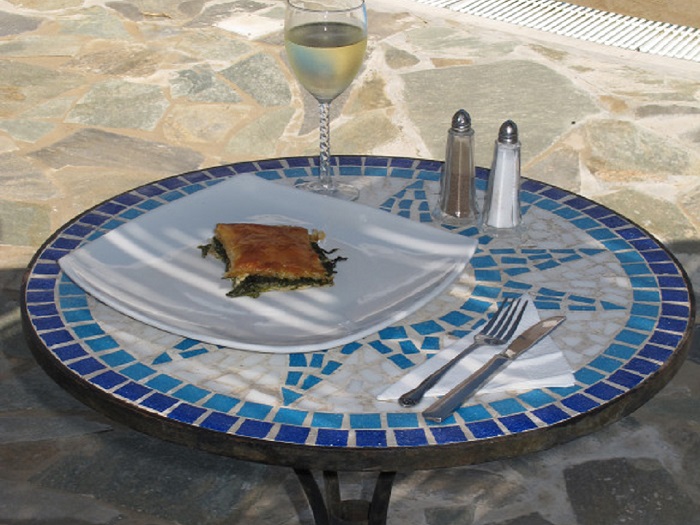
Spanakopita – Spinach pie
I can’t in all honesty say that my mother’s spinach pie is any better or different than the whole range of spinach pies that are made around Greece, although to be fair a lot of people have said that hers was the best they have ever tried! The ancient Greeks would stir in all sort of edible greens and wrap them to make pitas (pies), sadly, we don’t know how they made their pies as today’s spinach phyllo crusted pies first appeared during the Byzantine era. Spinach originated in ancient Persia (modern Iran). The rest of Europe had to wait well into the middle ages before they sampled this richly flavoured green. The English word spinach dates to 1530.
This will probably surprise many that have tried my mothers spanakopita as it is called in Greek but my mother did not make this dish at home and only started to make it when we opened the hotel! Coming from the Diapontian island of Ereikoussa (Erikousa), my mother was taught to make other sorts of pitas (pies) which I will reveal in later articles so when I wanted spanakopita on the menu she had to be taught to make it. Once again, my aunt Marika from Athens came to my mother’s rescue.
So popular was the dish when we first introduced it in Agios Stefanos that my mother had to make 2 pans of 15 portions on each pan a day! Several years later, when we would be selling of smaller amounts of the spanakopita, I wondered why people stop ordering it. Only to painfully realize that the other tavernas had started to sell it as well but as some of them would buy it in pre-made and frozen pockets of spanakopita, these would taste nothing like my mother’s homemade version so people would be dubious to try our spanakopita once they tried one of these other ones. How I would pine when I heard them say to me, “I have tried it before and don’t like it”!
My mother’s recipe is a bit different from all the others I have seen on the net but my mother told me that she started making it like those others but the recipe has evolved to the present one.
Prep Time: 30 minutes
Cook Time: 30 minutes
Total
Time: 1 hours
Servings: 10
Ingredients
- 3 tablespoons olive oil
- 1 onion, chopped
- 2-3 spring onions (scallion) roughly chopped
- 5 cloves of garlic, minced
- ½ cup (118 ml) chopped fresh fennel
- ¼ cup (59 ml) chopped fresh dill
- 4-5 fresh basil leaves, chopped
- 4-5 fresh mint leaves, chopped
- ½ cup water
- 2.5 pounds of spinach leaves
- 1 cup of crumbled Feta cheese
- 2 tablespoons grated Kefalotyri cheese (or Gruyere cheese)
- pinch of ground nutmeg
- 12 sheets phyllo pastry
- ¼ cup (59 ml) olive oil
Cooking Instructions
- Wash and drain the spinach leaves. Chop spinach coarsely. If using frozen spinach thaw completely and drain excess water. Spinach should be fairly dry.
- Add 3 tablespoons of olive oil in a deep saute pan, onions, green onions, garlic, fennel, dill and add half a cup water saute until soft and translucent so that the dill and fennel are well cooked, until they are soft as Theodora would say. She also uses these fresh from her garden so they are extra aromatic. Cook until most of the water evaporates.
- Stir in spinach, parsley, basil, mint, nutmeg and cook for 5 to 10 minutes until spinach has wilted and all excess moisture evaporates. Remove from heat and set aside to cool.
- In the next part, Theodora does it her way again. She does not use any eggs as most recipes use though it was in the original recipe of her aunts. Nor does she use ricotta cheese (which is Italian and Greeks would use Mizithra cheese which will be nearly impossible to find out side of Greece) simply because the feta cheese that she uses is very creamy and does not need another creamy cheese to help the dish.
- Take away from heat and add feta cheese and sprinkle some kefalotyri cheese and mix with the spinach mixture. Allow to cool.
- Prepare the Pita:
- Preheat oven to 150 degrees C (300 degrees F).
- Carefully remove the phyllo roll from the plastic sleeve. The biggest problem in working with phyllo is that once exposed to air, it tends to dry and the pastry sheets may break, so you will need to work quickly. To prevent drying, cover the phyllo roll with wax paper and a damp towel while working with the individual sheets.
- Lay one sheet of phyllo pastry on a flat surface and brush with olive oil then place in prepared baking dish.
- Lay 6 phyllo sheets in the pan, lightly brushing each with oil before adding the next layer. Brush all the edges first since that is where drying will begin.
- Spoon the spinach mixture over the top of the phyllo and carefully spread evenly and fold overhanging phyllo sheets over filling.
- Finish off with the remaining 6 sheets of phyllo, brushing each as previously done.
- Tuck overhanging phyllo sheets into the pan and seal filling.
- Carefully cut into squares before baking or else the phyllo leaves will crumble if it’s done afterwards.
- Bake in a preheated oven for 30 minutes or until golden brown.
- Serve hot or it can be refrigerated, re-heated in a normal oven as microwaves ovens make the phyllo pastry soggy.
- Enjoy!